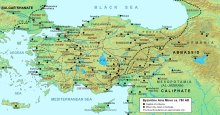Optimatoi
| Theme of the Optimatoi Ὀπτιμάτοι, θέμα Ὀπτιμάτων | |
|---|---|
Theme of the Byzantine Empire | |
| 740s–1204 1240–15th century | |
 Map of the administrative structure of the Byzantine Empire c. 780. The thema of the Optimatoi is located in the peninsula directly across the Bosporus, opposite Constantinople. | |
| Capital | Nicomedia (modern-day İzmit, Kocaeli, Turkey) |
| Historical era | Middle Ages |
• Established | 744/745 |
| ca. 1204 | |
• Byzantine recovery | 1240 |
• Conquest by Ottomans | 15th century |
The Optimatoi (
Asia Minor, which was named after them. As an administrative unit, the Theme of the Optimatoi (θέμα Ὀπτιμάτων, thema Optimatōn) survived until the Ottoman
conquest in the first decades of the 14th century.
History
The Optimates were first set up in the late 6th century (c. 575), by Emperor
Gothograeci (Γοτθογραίκοι) by the chronicler Theophanes the Confessor, is attested in northern Bithynia as late as the early 8th century.[5] At that time, Warren Treadgold estimates that the corps numbered 2,000 men, a figure that possibly corresponds to its original size as well.[3]
In the mid-8th century, under the rule of Emperor
Sangarius, was then constituted as the separate thema of the Optimatoi (θέμα Ὀπτιμάτων) with Nicomedia as its capital.[2][6] The first mention of the Optimatoi as a separate thema in the sources occurs only in 774/5,[7] but it is clear that its creation must have come in the years after the suppression of Artabasdos's revolt.[8] The same period also saw the further dismemberment and weakening of the once powerful Opsician Theme with the creation of the Bucellarian Theme.[9]
Henceforth, unlike the other themata, the Optimatoi no longer provided armed troops, but formed a corps of 4,000 mule-drivers with their animals, which provided the
Constantine VII Porphyrogennetos (r. 913–959) as a sign of inferior status.[2][11] Consequently, their commanding domestikos held the lowest rank of all provincial stratēgoi in the imperial hierarchy.[2] As with the other themata, for the administration of his duties as governor of the province, the domestikos was assisted by a deputy (topotērētēs), a chief financial official (chartoularios) and a secretariat headed by a prōtokankellarios.[12]
The rural districts of the thema were raided by
Ottoman beylik in the first half of the 14th century.[14]
References
- ^ Haldon 1999, p. 196.
- ^ a b c d e ODB, "Optimatoi" (C. Foss), p. 1529.
- ^ a b Treadgold 1995, pp. 96–97.
- ^ ODB, "Taxiarchos" (A. Kazhdan, E. McGeer), p. 2018.
- ^ Lounghis 1996, pp. 32–33.
- ^ Treadgold 1995, p. 99.
- ^ Turtledove 1982, p. 134.
- ^ Haldon 1984, pp. 222–227.
- ^ Lounghis 1996, pp. 29–31.
- ^ Haldon 1999, p. 158.
- ^ Lounghis 1996, p. 34.
- ^ Treadgold 1995, p. 105.
- ^ Treadgold 1995, p. 218.
- ^ a b ODB, "Nikomedia" (C. Foss), pp. 1483–1484.
Sources
- Haldon, John F. (1984). Byzantine Praetorians: An Αdministrative, Ιnstitutional and Social Survey of the Opsikion and the Tagmata, c. 580-900. Vol. 3. Bonn: R. Habelt. ISBN 3-7749-2004-4.
- Haldon, John F. (1999). Warfare, State and Society in the Byzantine World, 565-1204. London: University College London Press (Taylor & Francis Group). ISBN 1-85728-495-X.
- ISBN 0-19-504652-8.
- Lounghis, T. C. (1996). "The Decline of the Opsikian Domesticates and the Rise of the Domesticate of the Scholae". Byzantine Symmeikta. 10 (10): 27–36. ISSN 1105-1639.
- ISBN 978-0-8122-1128-3.
- ISBN 0-8047-3163-2.
